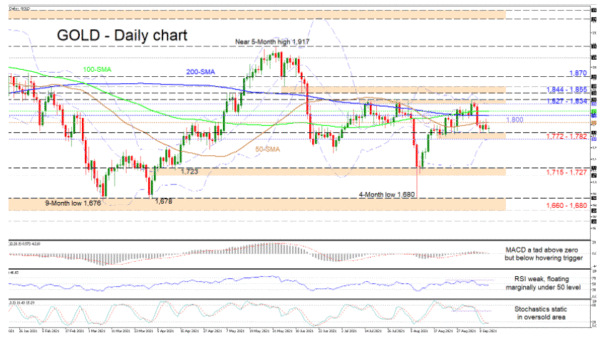Gold is edging sideways after retreating below the horizontal simple moving averages (SMAs) and the 1,800 level. Directional impetus in the price is absent, feeding a phase of consolidation in the precious metal, something also being endorsed by the converged SMAs.
The short-term oscillators are also lacking clear suggestions relating to the price’s next path as momentum appears to have dried up. The MACD is flat beneath its static red trigger line slightly north of the zero threshold, while the RSI is hovering underneath the 50 level. The stochastic lines have merged in oversold territory and have yet to signal any convincing directional preference in the price.
In order to boost upside momentum, buyers would need to initially push above a resistance zone existing between the 50-day SMA at 1,798 and the 100-day SMA at 1,816. Overstepping this tough barricade, the 1,827-1,834 curbing barrier, which began forming in mid-July could interrupt additional advances. However, if buyers conquer this obstacle and the upper Bollinger band, they may attack the 1,844-1,855 resistance border before eyeing the 1,870 inside swing high from June 10.
In the negative scenario, sellers face an immediate support base of 1,772-1,782, which is strengthened by the lower Bollinger band. Driving the price of the commodity beneath this barrier, next target support may emanate from the section of 1,715-1,727. From here, should the demand for gold continue to wane, the price could then target the long-term foundation of 1,660-1,680.
Summarizing, in the near-term picture gold is sustaining a neutral tone mostly fluctuating between 1,715 and 1,834. That said, a preliminary break below 1,772 or above 1,834 could set a price course into motion.
















